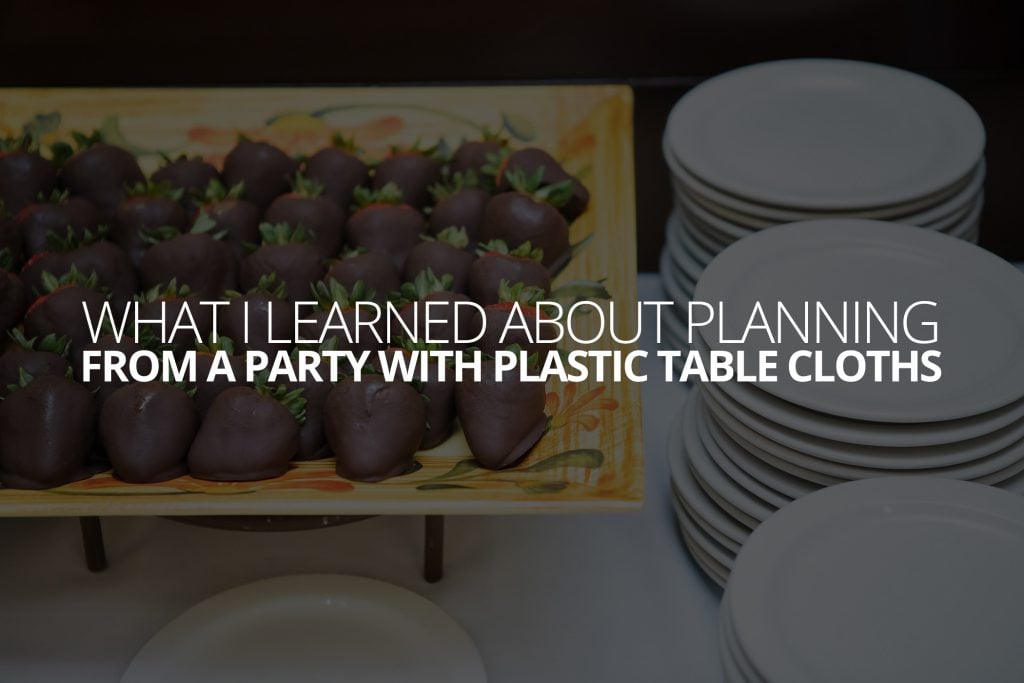A few weeks ago, the patriarch of the Petruzzo family (and the original Petruzzo-with-a-camera) turned 75, and his progeny had something in store for this birthday celebration.
Now, before I go on with this story, something you need to know is that in the Petruzzo family culture, we don’t make much of parties. We don’t throw them very often, and when we do we tend to focus on food and how we’ll spend time together. We almost completely eschew efforts toward decorations and event aesthetics. We usually bake our own cakes (yeah, from a box), we mix tableware that doesn’t even kind of match, our invitations usually consist of a text message a day or two in advance. The long and short of it is that neither I, nor my sisters, are ‘party planners’ in even the most generous sense of the term. Rather, we’re more like sentimentalists—“as long as we’re all together, who cares?”
Well, this party celebrating an important birthday, would be a little different. 75 years is a big deal, and we wanted to make sure we did something that felt like a big deal too. My oldest sister, after pioneering the idea, got to work on sending out invitations. We invited everyone we could think of, and even did a little covert reconnaissance to get contact information for friends none of us knew personally. We rented a big room from my father’s church to hold the party in, and we started brainstorming what to do.
As we went down the proverbial list (and I say proverbial because there was no literal ‘list’ to speak of), we ended up putting down a lot of TBD’s. What will we eat? TBD. Where will the tables come from? TBD. Chairs? TBD. How about music? Uhm, TBD. This wasn’t by design, and it wasn’t anyone’s fault exactly. The truth is, we all sort of thought someone else was doing or thinking about something that maybe we should have been doing or thinking about. The ‘hard part’—making sure everyone knew where and when to show up—was already done, so we all just sort of slipped into a normal family routine of expecting things to come together (after all, in our family, they usually do).
As we drew closer to the event, with a couple weeks to go, it started to dawn on us everything that hadn’t been done yet. A mild panic started to set in; this wasn’t a normal family dinner. It didn’t just need to come together, our effort needed to express our gratitude, both for our father and for his guests. Running around solving problems at the last second, or scrambling to prepare food, or constantly cleaning up the buffet table while guests milled around, would not communicate that. We needed to be physically, and mentally and emotionally present.
So, we buckled down and began a string of late nights and spreadsheets, and trips to and from and back to dozens of grocery stores and retailers. It was more than a little bit of a mess, but it did ‘come together’ nicely in the end. But, not without some clever make-shifting and imperfect tradeoffs to get there. For example, unable to figure out how to brew decent coffee for 150 people, we bought a Keurig off of Facebook marketplace, and brought another one we already had. Looking at the price on pre-made sandwiches, we decided to make them ourselves—about 340 of them. Realizing the church had no sound system we could tap into, we pulled a sound bar off the wall from a home theater system and hooked up an iPhone. I could go on.
But, it wasn’t until about 12 hours before the party started that our biggest faux pas came to light: Tablecloths.
As a professional photographer, and someone who goes to a lot of weddings, I have an aesthetic sensitivity that most others do not. Of course, this event was not a wedding, and the bar for ‘elegance’ was naturally set quite a lot lower, even for me. But one thing I’d taken for granted in all of my visualization of the day was the tablecloths. Yes, the innocuous, subtle accoutrement that set a kind of baseline for the ‘elegance’ of an event. In our family, one might even say that a cloth covering on the tables is the difference between a ‘get-together’, and a ‘party’.
The church was gracious enough to let us use their folding tables—8 foot round tables that seated around 7-8 people each. But to our dismay, we found that they did not have enough linens for all the tables we needed. Gasp.
So, we frantically headed out to the store to see what we could find. To make a long story short: Zilch. There were no cloth coverings available anywhere that would be able to cover these tables. We even considered make-shifting some curtains from Target into tablecloths, but the cost was prohibitive. I began to tap my network of event professionals who might be able to help us out in a pinch—but being a Saturday afternoon, no one was available. So, with some deep sighs of resignation, we bought some plastic table cloths and tried to just move on.
With the plastics in hand, we started spreading them out over the tables that were already arranged. And that’s when round two hit us. The folding tables were functionally just fine, but not in good aesthetic shape. The plastics would need to hide the marks on the table, but they were nearly see-through, so we’d have to double up the plastic to hide the messy tabletop surfaces and that’s when we discovered we didn’t have enough plastics to cover all the tables we needed. Confounded! We made another trip to the store, this time to discover that they didn’t have enough either. Once again, we made a pivot and changed the impromptu color scheme we’d come up with to something the store had in stock. We picked an off-white color which we’d mix and match with the forest-green color we’d already started working with.
It gets worse. The green table plastics we’d bought were see through enough to need two covers for each table. The white table plastics were see through enough to need three or four. Oy. Having already blown a ton of money on these one-time-use plastic table covers and rapidly running out of time, we gave up fighting that battle. Our guests would have to appreciate that we tried.
In spite of the plastic table cloths (which, admittedly, I cared about far more than anyone else), everyone had a good time. The food was good. The conversations were rich and plentiful. My father’s 75th birthday was thoroughly celebrated. Ultimately, there were no regrets from the event itself.
But, here’s the thing, and the whole reason I’m sharing this story right now:
We experienced a lot of stress putting this together and we spent more money than we should have. And the aesthetic qualities of the event were far, far less remarkable than they should have been considering those first two things. It’s all pretty much perfectly summed up in those plastic table cloths.
The table cloths were almost $4 each, so we spent around $200 on them when all was said and done. They didn’t look or feel particularly good, they didn’t cover the problems with the tables, and they were thrown out just a matter of hours after they were taken out of their package. A single table linen from a party rental supply company might run $7-10 for the day, so around the same amount. But, they would have looked 1000 times better, they would have elevated the aesthetic and atmosphere of the whole event, and they wouldn’t have produced all the waste.
But we waited too long. We took the planning for granted, and failed to consider the nuances of the event that make significant contributions to how everything would look and feel. Had we started those spreadsheets and late nights weeks or months earlier, the centerpieces my sister made might have had a lot more impact, the buffet table might not have looked so junky after the first spill, and the cost might have even been lower (well, at least the environmental cost).
The lesson I extrapolate from this experience is that there is genuinely no such thing as starting too early when planning an event, and especially a wedding where all these little details actually matter a lot more to how the event is experienced by you and your guests. If you plan very early, you have time to find the best deals, scoop up the best vendors, and make things work the way you want them to. The only reason we ended up with those janky plastic table coverings was because we didn’t plan soon enough.
Had we considered it earlier, we’d have discovered the rental cost for real table linens was comparable to those crappy plastic coverings, and we’d have definitely done that. And likewise, if you’re sitting two years out from a wedding date and twiddling your thumbs thinking you’ll pick a venue or a photographer or a caterer when you get closer—when The Wedding Wire calendar or whatever says you should book those things—you might be missing out on opportunities to lower your costs or raise your aesthetics or both. It’s not going to hurt to have a deposit sitting on a venue for two years, or having your photographer secured with more than a year to spare. But if you wait, you might find all that’s left are overpriced under-performing options you have no good alternatives for. It’s not worth it.
Learn from our mistakes, and start early.

